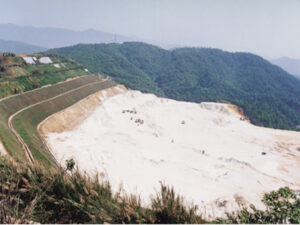[Overview] Sandy kaolin belongs to weathered or sedimentary deposit and mainly distributed in the subtropical rainy areas in the south, which is composed of kaolinite, quartz, feldspar and mica. The kaolinite content of its raw ores is generally 15-30%, and other minerals such as quartz, feldspar and mica with a particle size greater than 50μm accounts for over 50%. The main mineral component of kaolin is kaolinite, whose crystalline chemical formula is Al2O3·2SiO2·2H2O, and its theoretical chemical composition includes 46.54% SiO2, 39.5% Al2O3, and 13.96% H2O.
[Evaluation Indicator] The indexes to measure the processing characteristics of kaolin are composition, whiteness and brightness, particle size distribution, plasticity, binding, viscosity and thixotropy, drying property, sintering property, firing shrinkage, fire resistance, suspension and dispersion, selectivity, ion adsorption and exchange, chemical stability, electrical insulation and so on. One of the most important indexes is the whiteness, especially the high firing whiteness of kaolin used in the field of ceramics. The main factors affecting the whiteness are Fe, Ti and other dyeing substances. According to different processing parameters, it can be used as the basis for manufacturing different kinds of products.
[Beneficiation Technology] After pulping, desanding, grading, purification (magnetic separation or bleaching, this paper mainly refers magnetic separation), concentration, modification, pressure filtration, kaolin concentrate products can be obtained, which can be applied for ceramic or paper coating.
(1) Pulping and desanding classification process: the process is composed of ball mill, spiral classifier, high frequency screen, cyclone and so on. The raw ores are transported into the ball mill (high aluminum ball). After simple grinding and pulping, the separation of kaolin and quartz sand can be realized by spiral classifier, high frequency screen, cyclone and other equipment.
(2) Magnetic separation purification process: the magnetic separation process of kaolin is generally based on High Extraction Magnetic Filter(HEMF). According to the requirements of iron removal for different minerals, the process flow is flexible. The common forms are: one-stage vertical ring pulsating high gradient magnetic separator(WHIMS) + one-stage high extraction magnetic filter(HEMF), two-stage high extraction magnetic filter(HEMF) and etc. The performance of magnetic separation equipment, the ratio of medium and the setting of process parameters are all related to the purification effect.

(3) Modification process: some physical properties of kaolin need to be changed according to the application field of products, mainly referring to plasticity, bonding, viscosity and so on, which will not be detailedly described in this paper.
(4) Concentration and filter press process: it is mainly composed of thickener and frame filter press. When working, appropriate flocculant is added to increase the concentration effect and efficiency, and then kaolin products are obtained through the filter.
[Influencing factors] There are many indicators to measure the quality of kaolin. The common main indicators such as composition, whiteness and iron content are analyzed here from the perspective of ore feeding and magnetic separation conditions respectively. The ore feeding conditions mainly include grading particle size, processing capacity, concentration, dispersant content, and magnetic separation conditions covers magnetic field strength, medium ratio and so on. Details are as follows:
(1) Grading particle size: the grading particle size of sandy kaolin determines the quality of kaolin. Even if the same kaolin is just different in granularity classification, its aluminum content, whiteness, and iron content are different, leading to the difference in the composition of finished products. The granularity of sandy kaolin is classified according to -150 mesh, -200 mesh and -325 mesh.
(2) Processing capacity: when kaolin is purified, the processing capacity is related to product quality. Under the same conditions, the larger the processing capacity, the smaller the product whiteness improvement range. The handling capacity can be also understood as the flow rate of ore pulp.
(3) Concentration: in the purification of kaolin, the concentration is related to the processing capacity and purification effect of the product. The actual production concentration generally ranges from 15% to 25%, and the optimal concentration should be explored according to the specific mineral conditions. Under the same conditions, the higher the concentration is, the greater the processing capacity is. However, the purification effect will decrease accordingly.
(4) Dispersant content: Increasing dispersant can reduce the viscosity and improve the fluidity of kaolin, which not only increases the processing capacity, but improve the purification effect. In practical production, the amount of dispersant is generally 1~3‰, which is determined according to the use effect. Under the same conditions, the dispersant can improve the whiteness of the product by 1~3 degrees.
(5) Magnetic field intensity: the background magnetic induction intensity is the main parameter to characterize the performance of the magnetic separator. The background magnetic induction intensity condition of the magnetic separation process determines the effect of kaolin purification. With the same ore feeding conditions and production process, the higher the background magnetic field gradient, the better the iron removal effect.
(6) Medium ratio: under the condition of the same background magnetic induction intensity, the medium ratio of the magnetic separator is related to the whiteness of the purification of kaolin. In practical production, according to the effect of iron removal of different minerals, a variety of media are generally combined to form a composite media reactor for magnetic separation to achieve the best effect of iron removal.

[Summary] For a long time, sandy kaolin is mainly mining raw ore and rough processing products. Simple and extensive mining technology makes the quality of produced kaolin poor. In recent years, along with the industrial level upgrading, there is an increasing demand of high quality kaolin of all walks of life. Besides, with the development of the mineral processing technology and equipment, the processing technology of sandy kaolin purification is greatly improved and the quality of the kaolin is higher and higher. All of these results in the rising price, which has created remarkable economic and social benefits for the enterprise.







